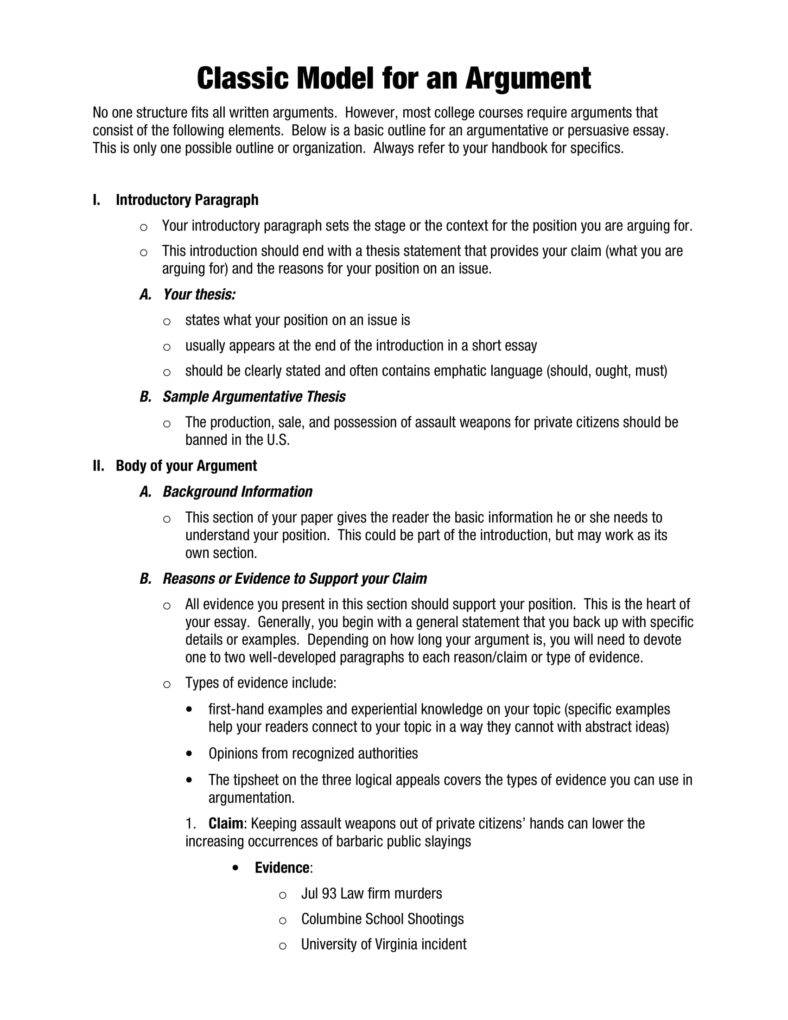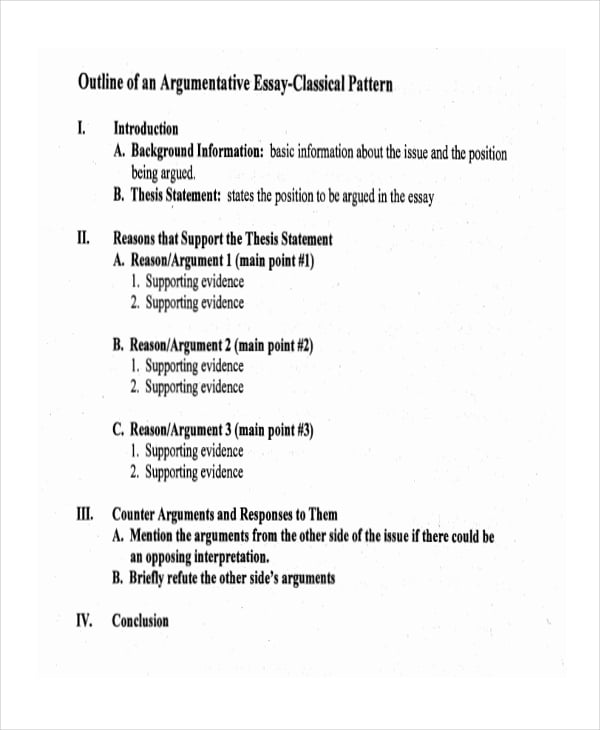
Start studying Classical Argumentative Essay Outline. Learn vocabulary, terms, and more with flashcards, games, and other study tools Classical Argument Structure: I. Introduction to general topic which leads to a clear thesis II. A moment of definition, background, and/or precedence (this is a section which clarifies and gives history on the topic or your stance on it). III. Support 1: This is typically the most logical reason why one should support your claim. a. Evidence b Outline of an Argumentative Essay – Classical Pattern. I. Introduction. A. Background Information: basic information about the issue (i.e. euthanasia) and the position being argued (i.e. euthanasia should/should not be allowed). B. Thesis Statement: states the position to be argued in the essay. II
The Classical Argument
Adapted from Walter Beale, Real Writing2 nd edition, One of the oldest organizing devices in rhetoric is the classical argumentclassical argument essay outline, which incorporates the five parts of a discourse that ancient teachers of rhetoric believed were necessary for persuasion, especially when the audience included a mixture of reactions from favorable to hostile.
They often prescribed this order to students, not because it was absolutely ideal, but because using the scheme encouraged the writer to take account of some of the most important elements of composing:. beginning in an interesting way. providing background or context that was relevant to their specific audience. stating their claims and evidence clearly and emphatically. taking account of opposing viewpoints and anticipating objections.
and concluding in a satisfying and effective way. But if you use the structure as a way to make sure you cover all the needs of all parts of your audience, you will find it a very useful heuristic for developing effective arguments.
The classical argument traditionally consists of five parts:, classical argument essay outline. In Writing. In writing, the first two parts classical argument essay outline the classical argument, the introduction and narrationare often run together. Since the writer needs to focus on grabbing and focusing attention rather than making the audience feel comfortable before beginning the argument, a written classical argument usually condenses these two elements into one.
The confirmationwhere you present the claims and evidence that back up or substantiate the thesis of your argument.
These claims and evidence are often connected together in a chain of reasoning that link the reasoningfacts and examples, and testimony i. inartistic proofs that support the main claim you are making. The concession and refutation sections, classical argument essay outline, which go together, classical argument essay outline, exist because classical argument essay outline always have more than one side. It is always dangerous to ignore them. Moreover, reasonable audiences often have more than one response to an argument.
So considering the opposing viewpoints enables a good arguer to anticipate and respond to the objections that her or his position might raise, and defuse opposition before it gets started. The introduction has four jobs to do:.
Classical argument essay outline Questions classical argument essay outline Ask as You Develop Your Introduction. What is the situation that this argument responds to?
What elements of background or context need classical argument essay outline be presented for this audience? Is this new information or am I just reminding them of matters they already have some familiarity with? What are the principal issues involved in this argument? Where do I stand on this issue? What tone should I establish? What image of myself should I project? But a rational audience has strong expectations of the kinds of proof you will and will not provide to help it accept your point of view.
Most of the arguments used in the confirmation tend to be of the inartistic kind, but artistic proofs can also be used to support this section. Some Questions to Ask as You Develop Your Confirmation. Again, here is a place to use both pathos and ethos : by conceding those matters of feeling and values that you can agree on, classical argument essay outline, while stressing the character issues, you can create the opportunity for listening and understanding.
But you will also have to refute that is, counter or out-argue the points your opposition will make. You can do this in four ways:. In general, classical argument essay outline, strategies 2 and 3 are easier to pull off than strategy 1. However, if you try to step back in your conclusion, you can often find a way to give a satisfying sense of closure. You might hark back to the background: why has this remained a problem and why is it so important to solve it, your way, now?
Or you might hark back to the common ground you have with your audience: why does accepting your argument reinforce your shared beliefs and values? And this sense of incompleteness leaves readers dissatisfied and sometimes less likely to accept your argument.
So spending a little extra time to round the conclusion out is almost always worthwhile in making the argument more successful. Some Questions to Ask as You Develop Your Conclusion.
The Classical Argument Adapted from Walter Beale, Real Writing2 nd edition, One of the oldest organizing devices in rhetoric is the classical argumentwhich incorporates the five parts of a discourse that ancient teachers of rhetoric believed were necessary for persuasion, especially when the audience included a mixture of reactions from favorable to hostile. They often prescribed this order to students, not because it was absolutely ideal, but because using the scheme encouraged the writer to take account of some of the most important elements of composing: beginning in an interesting way providing background or context that was relevant to their specific audience stating their claims and evidence clearly and emphatically taking account of opposing viewpoints and anticipating objections and concluding in a satisfying and effective way.
The classical argument traditionally consists of five parts: In Writing In writing, the classical argument essay outline two parts of the classical argument, the introduction and narrationare often run together.
How to Write a Good Argumentative Essay: Logical Structure
, time: 9:51Simple Argumentative Essay Outline | Template & Worksheet

One of the oldest organizing devices in rhetoric is the classical argument, which incorporates the five parts of a discourse that ancient teachers of rhetoric believed were necessary for persuasion, especially when the audience included a mixture of reactions from favorable to hostile. They often prescribed this order to students, not because it was absolutely ideal, but because using the scheme encouraged the Classic Model for an Argument No one structure fits all written arguments. However, most college courses require arguments that consist of the following elements. Below is a basic outline for an argumentative or persuasive essay. This is only one possible outline or organization. Always refer to your handbook for specifics. I. Introductory ParagraphFile Size: 57KB Writing Tip #1. This Argument Essay is a Classical Argument Essay aimed at both arguing the author’s thesis and refuting the opponent’s thesis. It is NOT a Persuasive Essay, where the purpose is to pursuade without necessarily arguing against an opposing perspective

No comments:
Post a Comment